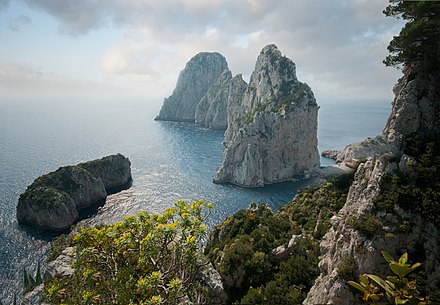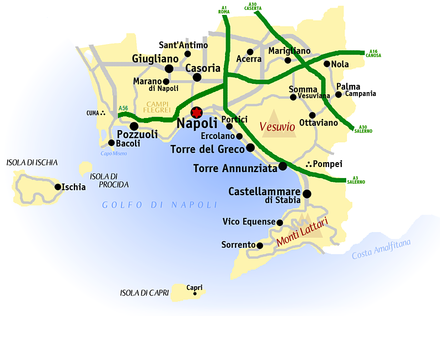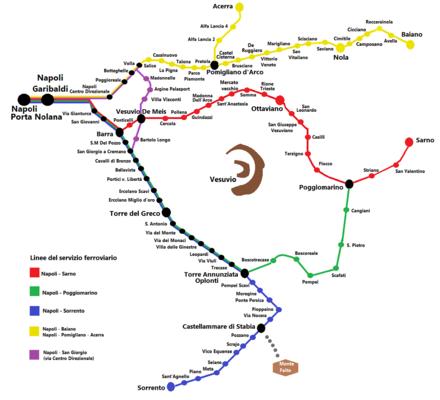Metropolitan Naples - former province in Italy
The City of Naples__ (dead link: January 2023) (Italian: Città metropolitana di Napoli) is a political entity in the Campania region of Italy. With 4.25 million inhabitants (2017), it is Italy's third largest metropolis behind Rome and Milan. Naples itself has just short of a million citizens, and an incredible amount of monuments and churches. The metropolis also has spectacular sceneries with the Vesuvius volcano, and the Roman ruin cities of Pompeii and Herculaneum.
Cities
- Naples – The capital, with 2,700 years of history.
- Afragola – The site of St. Anthony's basilica, in the northern hinterland.
- Castellammare di Stabia – villas of the ancient Roman city of Stabiae, spa resorts and the massive Mount Faito, accessible through a cable car.
- Massa Lubrense – Beautiful town close to Sorrento, but less touristy.
- Portici – A magnificent baroque Royal Palace and other 18th century villas.
- Pozzuoli – Two Roman amphitheaters and many other archaeological sites.
- Sorrento – pleasant locality overlooking the Bay, known worldwide for limoncello and other typical products.
- Torre Annunziata – Remains of the Roman city of Oplontis, spa and beach resort.
- Torre del Greco – The most populated city at the foot of Mount Vesuvius, famous for the manifacture of coral.
Other destinations

- Bacoli – many remains of Roman age, an underwater archaeological park and the Royal pavilion on Fusaro Lake built by Vanvitelli.
- Capri – the wonderful island of Blue Grotto, faraglioni an Roman villas.
- Herculaneum – Roman city buried by Mount Vesuvius along with Pompeii.
- Ischia – the largest island in the Bay, rich of spas and beach resorts.
- Pompeii – well preserved Roman city buried by Mount Vesuvius in 79 AD.
- Procida – the smallest of Bay's islands with enchanting pastel houses.
- Sant'Agnello – Located on the Sorrentine peninsula.
- Vesuvius – the only active volcano in continental Europe, 1,281 meters (4,203 ft) tall.
Understand
Metropolitan Naples hosts an unparalleled concentration of UNESCO World Heritage sites: Naples' old town; the Roman archeological sites of Pompeii, Herculaneum, Cumae, Pozzuoli, Oplontis and Stabiae; the Royal Palace of Caserta; the royal site of San Leucio, the Aqueduct of Vanvitelli, Paestum's Greek temples and the Amalfi Coast, also UNESCO's World Heritage sites, are possible day trips, as are the islands of Capri, Ischia and Procida in the Bay of Naples. Vesuvius is a UNESCO Biosphere Reserve.
Tourism itself has a long history in the region, as it was one of the southernmost destination of the Grand Tour in Early modern times.
Get in
By plane
- Naples International Airport (Aeroporto Internazionale di Napoli) (IATA: NAP, also known as Capodichino Airport), 40.8782°, 14.2828°, +39 081 789 6111, +39 081 789 6259, comunicazione@gesac.it. The main airport in Southern Italy, easily reachable by car thanks to the Tangenziale di Napoli (A 56 motorway). It is few kilometres north of the old town and by 2024 it will be connected to the local metro system. The airport is now linked to downtown Naples through Alibus, with stops at Piazza Garibaldi (central railway station), Porta di Massa (ferries port) and "Stazione marittima" (cruise ships and hydrofoils port). The first route requires 15 minutes while the others 35 minutes.
Taxi fares to reach the central railway station and the port are about €20. Instead, fares to nearby localities are: €80 round-trip to Herculaneum (2 hours of visit), €100 round-trip to Pompeii, €110 one way to Sorrento, €110 round-trip to Caserta, €140 one way to Amalfi. Check for more info
By train
 The main station of the Metropolitan city is Napoli Centrale 📍, situated in Piazza Garibaldi, just few steps from the historic centre. With 23 tracks it is one of main Italian railway stations and will allow you to reach Naples from the main cities of northern Italy quite quickly. With the Frecciarossa high speed trains of the national railway operator, links will require: 5 hr 45 min from Turin; 4 hr 20 min from Milan; 3½ hr from Bologna; 2½ hr from Florence; 1 hr 10 min from Rome. Check the site of Trenitalia for info about fares and routes.
The main station of the Metropolitan city is Napoli Centrale 📍, situated in Piazza Garibaldi, just few steps from the historic centre. With 23 tracks it is one of main Italian railway stations and will allow you to reach Naples from the main cities of northern Italy quite quickly. With the Frecciarossa high speed trains of the national railway operator, links will require: 5 hr 45 min from Turin; 4 hr 20 min from Milan; 3½ hr from Bologna; 2½ hr from Florence; 1 hr 10 min from Rome. Check the site of Trenitalia for info about fares and routes.
By car
 The territory is crossed by five autostrade (toll motorways):
The territory is crossed by five autostrade (toll motorways):
(Milan-Naples) – The main Italian road, allows to reach Naples from many important cities of the west-Tyrrhenian side of the country: Milan (7 hr); Bologna (5½ hr); Florence (4½ hr); Rome (2 hr) and just ½ hour from Caserta.
(Naples-Salerno) – Runs for 50 km (31 miles) through Portici (10 min), the sites of Herculaneum (15 min) and Pompeii (25 min), to arrive in Salerno in 40 minutes boarding the Amalfi Coast.
(Naples-Canosa di Puglia) – Connects the Tyrrhenian to the Adriatic coast of Apulia in the town of Canosa, not far from Bari. A useful way to arrive in the metropolitan city from the opposite coast in 2 hours.
(Caserta-Salerno) – Follows a route north of Mount Vesuvius and it can be useful to bypass the Naples area rather than reaching the most interesting tourist attractions.
(Tangenziale di Napoli) – Connects the Naples International Airport to Pozzuoli, crossing the northern suburb of the capital, with an exit at Capodimonte just few meters away from the namesake Royal Palace. The site of Autostrade per l'Italia (dead link: January 2023) gives info about charge calculation for your route.
Get around
By train
Circumvesuviana
 The Circumvesuviana
The Circumvesuviana is a railway network that counts 97 stations on six lines that connect different towns of eastern metropolitan Naples area to the capital, to the terminal station of Napoli Porta Nolana 📍, passing through the central railway station of the city. It takes the name because most of its lines form a ring around Mount Vesuvius, so it is usually called the "vesuviana". This transport service can be really useful to tourists since it allows links from Naples to Herculaneum, Pompeii and Sorrento quite quickly. Most of the route is at ground level, except few stretches especially in Naples.
The system uses a narrow gauge and comprises six lines:
- [sorrento]: The most tourist route since passes through Herculaneum, Pompeii and the Sorrentine peninsula (1 hr)
- [poggiomarino]: Passes through the modern town of Pompeii. (1 hr)
- [sangiorgio]: Sometimes called Line 3 of Naples metro, links the eastern suburb of the capital. (15 min)
- [baiano]: Runs to the little town in the province of Avellino via Nola and Avella, where is located a Roman amphitheater. (1 hr)
- [acerra]: Runs northward until the city of the archaeological remains of Suessula. (½ hr)
- [sarno]: Runs to this town in the province of Salerno passing north of Mount Vesuvius. (1 hr)
Circumflegrea
 The Circumflegrea [circumflegrea] be considered the western counterpart of Circumvesuviana since runs towards localities situated in the volcanic area of Phlegraean Fields. The service consists in a single line connecting the terminal station of Napoli Montesanto 📍 (in the middle of the old town) to Torregaveta, on the Gulf of Gaeta. In 2018 the line was fully operational only until the station of Licola, but the final section is open on sunday and particular dates from 22 May to 30 October to allow visiting the archaeological site of Cumae. Check for more info
The Circumflegrea [circumflegrea] be considered the western counterpart of Circumvesuviana since runs towards localities situated in the volcanic area of Phlegraean Fields. The service consists in a single line connecting the terminal station of Napoli Montesanto 📍 (in the middle of the old town) to Torregaveta, on the Gulf of Gaeta. In 2018 the line was fully operational only until the station of Licola, but the final section is open on sunday and particular dates from 22 May to 30 October to allow visiting the archaeological site of Cumae. Check for more info
Cumana
 The Cumana [cumana] railway consists in a single line that shares the two terminal stations of Napoli Montesanto and Torregaveta with the Circumflegrea, but running along the coastline south of Phlegraean volcanic craters. It allows to move from Naples' historic centre to its western suburbs and Pozzuoli until reaching the sandy coast of the Gulf of Gaeta. This service is operated by Ente Autonomo Volturno (EAV), the company that manages also the two railway networks described above. This line is famous amongst the locals for its unreliability and disorganization despite improvements by the operator.
The Cumana [cumana] railway consists in a single line that shares the two terminal stations of Napoli Montesanto and Torregaveta with the Circumflegrea, but running along the coastline south of Phlegraean volcanic craters. It allows to move from Naples' historic centre to its western suburbs and Pozzuoli until reaching the sandy coast of the Gulf of Gaeta. This service is operated by Ente Autonomo Volturno (EAV), the company that manages also the two railway networks described above. This line is famous amongst the locals for its unreliability and disorganization despite improvements by the operator.
See
Do
Eat
Drink
Stay safe
Go next
There are many interesting places to visit at the edge of the Metropolitan City:
- Amalfi Coast - Every single village along this stretch of coast is a true jewel and is worth visiting.
- Caserta - The enormous Royal Palace is at 28 km (17 miles) north of Naples.
- Irpinia - A mountain, green district with beautiful sights and its own culture and cuisine, at 50 km (31 miles) east of Naples.
- Santa Maria Capua Vetere - Impressive remains of the second largest Roman amphitheater, place of the revolt of Spartacus' outbreak.
- Paestum - Greek temples and Roman remains; 100 km (62 miles) south of Naples.
If you want to go further visit the neighbouring regions:
- Lazio - The "Eternal City" is just at 1½ hour of high speed train. Tivoli and the Abbey of Monte Cassino are also easily reachable.
- Apulia - "Trulli" of Alberobello and many other tourist attractions are waiting for you! Various private bus companies offer efficient connections.
- Basilicata - "Sassi" of Matera, pleasant medieval villages and castles. Private bus companies are the best option to get in the region.
- Calabria - White sandy beaches, large thick woods, ski resorts and remains of Magna Graecia's colonies all in one region!
- Sicily - The largest island of Mediterranean Sea, with its fascinating monuments, coast and cuisine. The capital Palermo can be reached in 1 hour by plane.
Province of Naples
provincia.napoli.itCampania
Primary administrative division